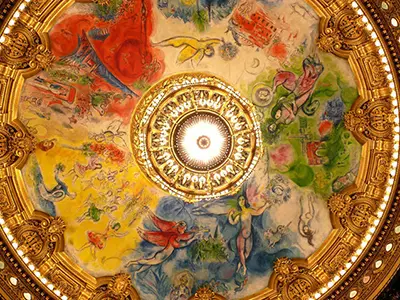You will see immediately from the photograph included in this page of the five main sections of this artwork, which are rotated around a circular layout which fills the centre of the ceiling in this room. A chandelier then hangs from the centre. Each of the individual artworks have a different background colour, with red, white, blue, green and yellow being the chosen tones. These were common additions to the palettes of Chagall throughout his career and he would re-use these colours on the objects within each section. It would have been a logistical challenge to produce this painting, working in a way that was very different to how he normally would put his artworks together, but the actual paintings themselves did not diverge too much from his standard oil on canvas works that had helped him to achieve such impressive levels of fame across Europe, and later, the US.
Chagall adored bright colours, but it was not until his arrival in France that he became aware of the possibilities of these types of tones. He had been introduced to far more subdued colour schemes whilst working in Eastern Europe and it seemed that his arrival in the west would unleash many new ideas and inspirations that would take his career into a new direction. Without this change, he likely would not have become as popular as he has done, and it is these same tones of reds, blues and greens that have led to so many ordering prints of his paintings in the present day, many decades after his career came about. One can make a similar comparison to Vincent van Gogh, and the contrast between his work in Northern Europe before he relocated to Southern France.
This overall project was highly significant in how traditional Renaissance and Baroque methods were replaced by something far more contemporary. Matisse produced a similar alternative within 20th century France, as well. However, we normally consider far more traditional artists for these types of projects, the likes of Michelangelo's Creation of Adam springs to mind for example, or perhaps some of Rubens' and Van Dyck's extraordinary creations all those many years ago. So whilst Chagall's work looks stunning, the significance of this project goes way beyond that, marking a point at which the academics have accepted contemporary art and allowed it to flourish even in the most traditional and classical of settings. It is offers another string to the bow of this highly versatile painter who continually sought, and was offered, new ways in which to express himself.
